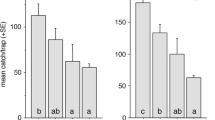Abstract
In first, preliminary experiments, the efficacy of the CzechBeauveria bassiana product „Boverol” alone and in combination with pheromone traps on the mortality and the breeding behavior of the bark beetle,Ips typographus, was investigated. Pathogenicity tests resulted in a mortality due to the fungus of 88.0 to 96.7%. When the beetles were given directly after superficial contamination on fresh spruce pieces with bark, the reduction of the breeding efficacy was 23 to 29% compared to the untreated control. No differences between the hatched beetles from the F1-generation of contaminated beetles and those of the untreated control beetles were observed. A transfer of the fungus from the parent beetle to the young beetle was noticed only in a few cases. In the field, the efficacy of a combination of a pheromone trap withB. bassiana was tested. The number of bore holes and the breeding was measured using a caged spruce log. In the combination, the number of bore holes was reduced by 15%, but the F1-generation nearly by 60%. Possible strategies for the use ofB. bassiana in combination with pheromone traps againstIps typographus are discussed.
Zusammenfassung
In ersten, orientierenden Versuchen wurde die Wirkung des tschechischenBeauveria bassiana-Präparates „Boverol” allein und in Kombination mit Pheromonfallen auf die Mortalität und das Brutverhalten des Buchdruckers,Ips typographus, untersucht. Pathogenitätstests ergaben eine Verpilzungsrate von 88,0 bis 96,7%. Wurden Käfer nach der oberflächlichen Kontamination sofort zur Brutablage an frische, berindete Fichtenstücke gesetzt, so betrug die Reduktion der Brutleistung gegenüber der Kontrolle nur etwa 23 bis 29%. Bei der geschlüpften F1-Generation von kontaminierten Altkäfern konnten keine Unterschiede zu den vergleichbaren Jungkäfern aus der unbehandelten Kontrolle festgestellt werden. Eine Übertragung des Pilzes vom Altkäfer auf den Jungkäfer fand nur in Ausnahmefällen statt. Im Freiland wurde die Wirkung einer Kombination von Pheromonfalle mitB. bassiana getestet, wobei das Einbohrverhalten und die Brutleistung der Käfer in einer darunter eingekäfigten Fichtenrolle überprüft wurden. Die Zahl der Einbohrlöcher war in der BOVEROL-Variante um etwa 15% verringert, die F1-Generation jedoch um nahezu 60%. Mögliche Einsatzstrategien vonBeauveria bassiana mit Hilfe von Pheromonfallen beiIps typographus werden erörtert.
Similar content being viewed by others
Literatur
Arbeitsgruppe Waldschutz, 1993: Borkenkäfer überwachen und bekämpfen. Merkblatt Nr. 1015/1993 des Auswertungs-und Informationsdienstes für Ernährung, Landwirtschaft und Forsten (AID), Bonn, 36 S.
Bathon, H., 1991: Möglichkeiten der biologischen Bekämpfung von Borkenkäfern. In: Borkenkäfer-Gefahren nach Sturmschäden,A. Wulf, R. Kehr (Hrsg.), Mitt. aus der Biol. Bundesanst. für Land- und Forstw., Heft 267. Berlin: Paul Parey Kommissionsverlag, 111–117.
Dimitri, L.;König, E.;Niemeyer, H.;Vaupel, O., 1986: Der Dreifallenstern: Eine Möglichkeit zur Steigerung der Effektivität von Borkenkäferfallen. Forst-und Holzwirt.41, 171–173.
Dimitri, L.;Gebauer, U.;Lösekrug, R.;Vaupel, O., 1992: Influence of mass trapping on the population dynamic and damage effect of bark beetles. Z. ang. Ent.114, 103–109.
Dubbel, V.;Dimitri, L.;Niemeyer, H.;Vaupel, O., 1995: Borkenkäferfallen-sinnlos bei Massenvermehrungen? Allg. Forstz.50, 258.
Klimetzek, D.; Vité, J. P., 1989: Tierische Schädlinge. In:Schmidt-Vogt, H.: Die Fichte, Bd. II/2, 40–133.
Krieg, A.;Franz, J. M., 1989: Lehrbuch der biologischen Schädlingsbekämpfung. Paul Parey Verlag, Berlin/Hamburg, 302 S.
Matha, V.; Weiser, J., 1985: Effect of the fungusBeauveria bassiana on adult bark beetlesIps typographus. Conf. Biol. Biotechn. Contr. Forest Pests 1985, Tabor (CSFR).
Niemeyer, H.;Dimitri, L.;Vaupel, O., 1990: Verminderung von Borkenkäferpopulationen. AFZ45, 770–773.
Niemeyer, H.;Watzek, G.;Ackermann, J., 1994: Verminderung von Stehendbefall durch Borkenkäferfallen. AFZ49, 190–192.
Nierhaus-Wunderwald, D., 1993: Die natürlichen Gegenspieler der Borkenkäfer. Wald und Holz (Sonderdruck), Nr.1/93, 8–14.
Pehl, L.;Kehr, R., 1994: Biologische Bekämpfung von Borkenkäfern. AFZ49, 1065–1067.
Pell, J. K.;Macaulay, E. D. M.;Wilding, N., 1993: A Pheromone Trap for Dispersal of the PathogenZoophthora radicans Brefeld (Zygomycetes: Entomophthorales) amongst Populations of the Diamondback Moth,Plutella xylostella L. (Lepidoptera: Yponomeutidae). Biocontrol Science and Technol.3, 315–320.
Postner, M., 1974: Scolytidae, Borkenkäfer. In:Schwenke, W. (Hrsg.). Die Forstschädlinge Europas, Bd.2, 334–482.
Prazak, R., 1991: Studies on indirect infection ofTrypodendron lineatum Oliv. withBeauveria bassiana (Bals.) Vuill. J. Appl. Ent.111, 431–441.
Schwenke, W., 1996: Grundzüge des Massenwechsels und der Bekämpfung des Großen Fichtenborkenkäfers,Ips typographus (L.) (Col., Scolytidae). Anz. Schädlingskde., Pflanzenschutz, Umweltschutz69, 11–15.
Vaupel, O.;Dimitri, L.;Vité, J. P., 1981: Untersuchungen über den Einsatz von lockstoffbeköderten Rohrfallen zur Bekämpfung des Buchdruckers (Ips typographus L.) sowie Möglichkeiten der Optimierung von Lockstoffverfahren. Allg. Forst- u. J.-Ztg.152, 102–113.
Vaupel, O.;Dimitri, L.;König, E.;Berwig, W., 1986: Zur Optimierung des Falleneinsatzes bei Buchdrucker und Gestreiftem Nutzholzborkenkäfer. Allg. Forstz.41, 572–574.
Wegensteiner, R., 1992: Untersuchungen zur Wirkung vonBeauveria-Arten aufIps typographus (Col., Scolytidae). Mitt. Dtsch. Ges. Allg. Angew. Ent.8, 104–106.
Wegensteiner, R., 1995: Laboratory evaluation ofBeauveria bassiana (Bals.) Vuill. against the bark beetle,Ips typographus (L.) (Coleoptera, Scolytidae). Vortrag beim 5. European Meeting: Microbial Control of Pests in IOBC/WPRS u. EPRS; in Poznan (Poland); IOBC-Bull. (im Druck).
Wulf, A., 1979: Der insektenpathogene PilzBeauveria bassiana (Bals.) Vuill. als Krankheitserreger des KupferstechersPityogenes chalcographus L. (Col., Scolytidae). Diss. Forstl. Fak., Univ. Göttingen.
Wulf, A., 1983: Untersuchungen über den insektenpathogenen PilzBeauveria bassiana (Bals.) Vuill. als Parasit des BorkenkäfersPityogenes chalcographus L. (Col., Scolytidae). Z. Ang. Ent.95, 34–46.
Zimmermann, G., 1994: Strategies for the utilization of entomopathogenic fungi. Proceed. (Vol. I) VIth. Intern. Colloqu. Invert. Pathol. and Microbial Control, Montpellier, France, 1994, 67–73.
Author information
Authors and Affiliations
Additional information
Mit 4 Abbildungen
Rights and permissions
About this article
Cite this article
Vaupel, O., Zimmermann, G. Orientierende Versuche zur Kombination von Pheromonfallen mit dem insektenpathogenen PilzBeauveria bassiana (Bals.) Vuill. gegen die Borkenkäferartlps typographus L. (Col., Scolytidae). Anz. Schadlingskde., Pflanzenschutz, Umweltschutz 69, 175–179 (1996). https://doi.org/10.1007/BF01908440
Issue Date:
DOI: https://doi.org/10.1007/BF01908440




